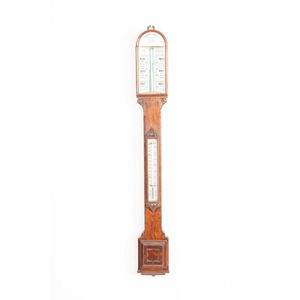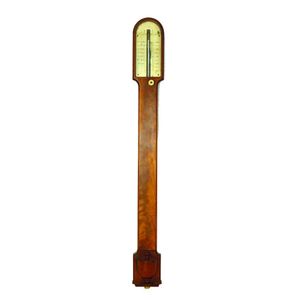Mahogany Longcase Clock by Lancaster & Sons
You must be a subscriber, and be logged in to view price and dealer details.
Subscribe Now to view actual auction price for this item
When you subscribe, you have the option of setting the currency in which to display prices to $Au, $US, $NZ or Stg.
- Mahogany - Mahogany is a dense, close grained red-coloured timber from the West Indies and Central America. It was first imported into Europe in the the early 18th century and its use continued through the 19th century. It was popular for furniture making because of its strength, the wide boards available, the distinctive grain on some boards, termed flame mahogany and the rich warm colour of the timber when it was polished.. The "flame" was produced where a limb grew out from the trunk of the tree, and this timber was usually sliced into veneers for feature panels on doors, backs and cornices.
Some terms used to describe mahogany relate to the country from which it originally came, such as "Cuban" mahogany, "Honduras" mahogany etc. However unless the wood has been tested the names assigned are more a selling feature, rather than a true indication of the timber's origin. - Date Aperture - A date aperture is a cut out section in the face of a watch or clock, displaying the day of the month.
This item has been included into following indexes:
Visually similar items

George III oak longcase clock by Thomas Brown of Birmingham, circa 1780, eight day, brass brake, arch dial, small seconds hand, date disk, striking on bell, London style hood, with key, 260 cm height

A George III mahogany longcase clock signed C Fenwick Crieff 1826, having a painted dial subsidiary for seconds, date aperture, with twin train movement the trunk enclosed by with waist panel door between canted corners. 214 cm high

A late Victorian oak cased mercury stick barometer by Camerer Cuss, London, c.1900. Two glass fronted panels for Rise and fall with adjusting scales and a thermometer in Centigrade and Fahrenheit. Height 101 cm

A Georgian mahogany stick barometer, with barometric scales inscribed to the arched face above a plain column with a mahogany urn decoration to the base, height 95 cm
